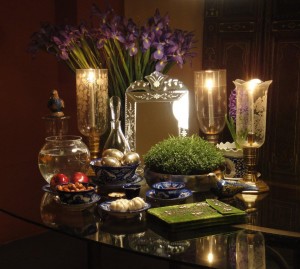The Spring Day was Nowruz, the Persian’s New Year’s day. Thanks to my dear colleague B., I’m discovering the Persian cooking. The New Year’s Day traditional meal is called Sabzi Polo Mahi, which is rice with green herbs served with fish. The traditional seasoning for Sabzi Polo are parsley, coriander, chives, dill and fenugreek.
The traditional table setting of Nowruz is Haft-Sin (Persian: هفتسین) or the seven ‘S’s. The haft seen table includes seven specific items, all starting with the sin (س) in the Persian alphabet.
The Haft Seen items are:
- Sabzeh – wheat, barley, mung bean or lentil sprouts growing in a dish – symbolising rebirth
- Samanu – sweet pudding made from wheat germ – symbolising affluence
- Senjed – dried oleaster fruit – symbolising love
- Sir – garlic – symbolising medicine
- Sib – apples – symbolising beauty and health
- Somāq – sumac fruit – symbolising (the color of) sunrise
- Serkeh – vinegar – symbolising old-age and patience
Haft Seen may also include decorated eggs symbolising fertility, a bowl with goldfish symbolising life, poetry book, such as the Shahnameh or the Divan of Hafez, or a religious text such as the Quran or Avesta.

